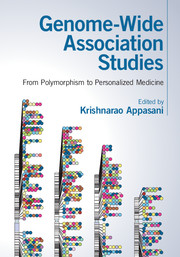Book contents
- Frontmatter
- Dedication
- Contents
- List of contributors
- Forewords
- Preface
- List of abbreviations
- Part I Genome-wide association studies
- Part II Genome-wide studies in disease biology
- Part III Single nucleotide polymorphisms, copy number variants, haplotypes and eQTLs
- Part IV Next-generation sequencing technology and pharmaco-genomics
- Part V Population genetics and personalized medicine
- 21 Population stratification and its implications: lessons from genome-wide studies
- 22 How to solve genetic disease on a population scale
- 23 Economics of personalized medicine
- Index
- Plate section
- References
21 - Population stratification and its implications: lessons from genome-wide studies
from Part V - Population genetics and personalized medicine
Published online by Cambridge University Press: 18 December 2015
- Frontmatter
- Dedication
- Contents
- List of contributors
- Forewords
- Preface
- List of abbreviations
- Part I Genome-wide association studies
- Part II Genome-wide studies in disease biology
- Part III Single nucleotide polymorphisms, copy number variants, haplotypes and eQTLs
- Part IV Next-generation sequencing technology and pharmaco-genomics
- Part V Population genetics and personalized medicine
- 21 Population stratification and its implications: lessons from genome-wide studies
- 22 How to solve genetic disease on a population scale
- 23 Economics of personalized medicine
- Index
- Plate section
- References
Summary
Introduction
It is a well-established fact that the anatomically modern human originated in Africa about 200 thousand years ago (KYA) and migrated out-of-Africa about 60–70 KYA. In this process, several populations arose and each of them has their own evolutionary history. Genetic drift, endogamy practices, admixture, and natural selection are examples of a few evolutionary phenomena leading to genetic diversity among populations around the world including susceptibility and resistance to genetic diseases, infectious diseases, therapeutic response to drugs, etc. Understanding these phenomena is much more relevant in a country like India, which has the richest ethnic, cultural, linguistic, and social diversity in the world and harbors 4635 anthropologically well-defined populations, among which 532 are tribes, including 72 primitive tribes (36 hunters and gatherers). In simple terms, there are populations in India who are phenotypically similar to Africans (Andamanese), some are similar to Europeans, some are similar to southeast Asians, and some are not related to any populations outside India. Most interestingly, Indian populations differ from each other with respect to their social structure, language, marriage practices, dress and food habits, physical appearance, etc. They are inhabitated in a variety of the geographical realms, ranging from scorching desert to evergreen forest, fertile plains to the southern dry plateaus, lowlands to the breath-taking high Himalayas. Broadly, Indians speak four major families of languages: Indo-European, Dravidian, Austroasiatic, and Tibeto-Burman. In addition, India has two distinguished isolated languages, namely Andamanese and Nihalis spoken in Andaman and Nicobar Islands, and pockets of Madhya Pradesh and Maharashtra, respectively. In addition to the indigenous populations, India experienced migration of several populations in the recent past. With everything mentioned above about India, it is tempting to say that India is an “ethnic museum.” This chapter is intended to highlight the Indian population structure and its important implications.
Population stratification: India as an example
India is known for its social stratifications that include castes, tribes, and religious groups. The Rig Veda, which was written between 1700 and 1100 BC (Rao et al., 2009), is considered to be the oldest written evidence about the existence and organization of the caste system. The precise date of origin of the caste system in India is still unclear. Initially, the newborn individual was devoid of any predefined caste. Later, one's caste was assigned based on the profession followed in the course of their life.
- Type
- Chapter
- Information
- Genome-Wide Association StudiesFrom Polymorphism to Personalized Medicine, pp. 315 - 340Publisher: Cambridge University PressPrint publication year: 2016

